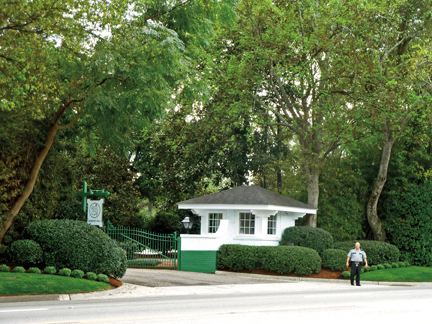Augusta – Home of The Masters
Posted on April 1, 2014 by bob in Travel
by Andrea Gross; photos by Irv Green
My husband is being accosted by a burly man in a guard’s uniform. I’m standing across the street, and I see the man point his finger toward the corner. My husband starts to say something. The man steps closer. I hold my breath, but my husband tightens his hold on his camera, turns and walks away. Quickly.
And that is as close as either of us gets to the hallowed grounds of the Augusta National Golf Club, home of the Masters® Tournament, one of the country’s most prestigious sporting events.
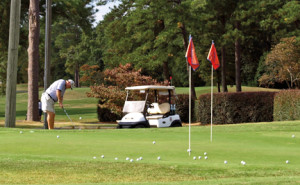 We know before we arrive that we won’t be able to get on the course. To do that, you have to be very important, very rich or very lucky. (Winners of a random drawing are allowed to purchase tickets.) But we did think we might be able to peek through the gates and glimpse the clubhouse, or at least some green grass. Evidently not.
We know before we arrive that we won’t be able to get on the course. To do that, you have to be very important, very rich or very lucky. (Winners of a random drawing are allowed to purchase tickets.) But we did think we might be able to peek through the gates and glimpse the clubhouse, or at least some green grass. Evidently not.
The Masters, held each year during the first full week in April, is a highly secretive business. There are no tours of the course, not even when it’s empty. For that matter, the famed pimento sandwich — a cheesy concoction spread between two slices of white bread — can only be purchased at the tournament. You can’t even find an official recipe, although many have tried to duplicate it. They’ve come close but, say those who’ve tasted the authentic sandwich, they haven’t “mastered” it completely.
But my husband isn’t one to give up easily. If he can’t walk the course where the Masters is played, he’ll walk in the footsteps of the one who co-created and designed that course, renowned golfer Bobby Jones. Thus we head to Forest Hills Golf Course where, in 1930, Jones began his historic Grand Slam, winning four major tournaments in a single calendar year. Forest Hills, like many courses in the area, is open to the public, thus allowing amateur golfers to breathe the same rarefied Augusta air as that inhaled by the masters of the Masters.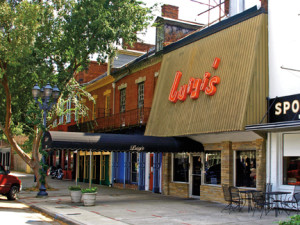
Most of these golf greats have eaten at Luigi’s, reputedly the best place in town for a “golfer sighting” as well as a terrific place for Greek and Italian food. Jack Nicklaus and his family often order a take-out box for their plane ride home, and Ben Crenshaw makes it a point to stop by whenever he’s in town.
Our last golf-related stop is the Augusta Museum of History. We walk into the rotunda where we’re greeted by life-size statues of five legendary golfers. Upstairs we see a green jacket, representative of those given to the winners of the Masters, and learn more about golf’s importance to Augusta’s economy. For example, 80 percent of the golf cars in the world are made in Augusta.
 While my husband continues to ogle golf memorabilia, I go to an adjacent room to learn about Mr. James Brown, who lived in Augusta as a child. Excellent displays trace Brown’s life from his early days as a shoeshine boy to his later years when he became the “Godfather of Soul.” Now two of Augusta’s most frequented sites — the historic downtown district and the recently-built riverwalk park— are joined by a thoroughfare named James Brown Boulevard.
While my husband continues to ogle golf memorabilia, I go to an adjacent room to learn about Mr. James Brown, who lived in Augusta as a child. Excellent displays trace Brown’s life from his early days as a shoeshine boy to his later years when he became the “Godfather of Soul.” Now two of Augusta’s most frequented sites — the historic downtown district and the recently-built riverwalk park— are joined by a thoroughfare named James Brown Boulevard.
Woodrow Wilson also spent much of his childhood in Augusta, and the two-story brick home where he lived is just a few blocks away. During the Civil War the young Wilson could look out his bedroom window and see the hospital grounds where wounded soldiers awaited medical care. Many people think this experience explains his reluctance to involve the U.S. in WW I. 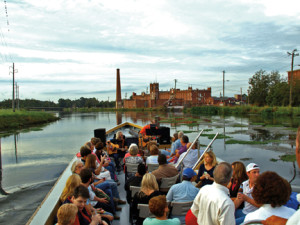
By the time of the Civil War, Augusta was a thriving industrial center, largely due to the Augusta Canal, which provided power for plants and factories. We stop at the small but immensely informative Canal Interpretive Center before boarding an open-air boat for a narrated cruise down the waterway. It’s a leisurely ride that winds past old homes, mills and warehouses, all reminiscent of Augusta’s glory days.
While the canal is still being used for its original purpose, other things have changed. The waterfront and downtown areas are being revitalized as many of the old buildings, which had been empty for years, are being converted into classy galleries and trendy eateries.
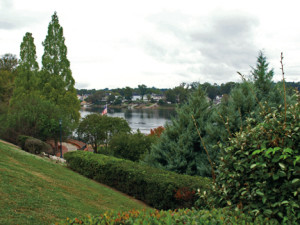 We end our stay in Augusta by devising our own Pimento Tasting in hopes of discovering a cheesy delight that’s as good as the one used on the sandwiches sold at the Masters. We immediately notice one difference: The downtown restaurants serve their pimento mixes with toasted pita points or crostini rather than atop squishy white bread. But there’s also a similarity: They’re all sinfully delicious.
We end our stay in Augusta by devising our own Pimento Tasting in hopes of discovering a cheesy delight that’s as good as the one used on the sandwiches sold at the Masters. We immediately notice one difference: The downtown restaurants serve their pimento mixes with toasted pita points or crostini rather than atop squishy white bread. But there’s also a similarity: They’re all sinfully delicious.
As we’ve learned, there’s more to Augusta than the Masters.










